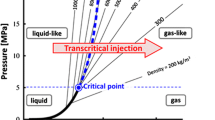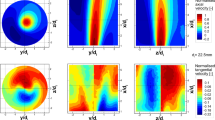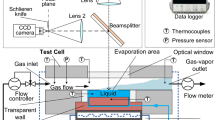Abstract
We present preliminary results of the visualization of a submerged coflow jet of liquid helium produced by a fountain pump. The jet propagating inside the bulk superfluid is visualized with particle tracking velocimetry using hydrogen particles. We compare the characteristics of the coflow jet with those measured in classical fluids such as helium gas or water. In contrast to the classical experiments, a temperature-dependent angle of the jet is observed, suggesting that the flow may not be described quasi-classically, despite the strong coupling between normal and superfluid components by mutual friction. We report on the statistics of the velocities inferred from the particle trajectories recorded by a high-speed camera at 1.68 and 1.95 K, for jet velocities ranging from 47 to 4500 mm/s.
Similar content being viewed by others
Avoid common mistakes on your manuscript.
1 Introduction
The visualization of turbulent flows [1,2,3,4,5] has become an important tool for the study of superfluid turbulence in several experimental flow situations. We present results of an experiment for visualizing a turbulent jet of superfluid helium as it enters a liquid-filled region, at temperatures below the Lambda point. Both the normal and the superfluid component flow together in our setup (coflow), as in the classic experiment of Allen and Jones [6]. This is fundamentally different from previous visualization studies [7,8,9,10], where the two components moved in opposite directions (counterflow).
2 Experimental Details
Our main experimental goal was to capture the motion of particles dispersed in the bulk superfluid and measure their velocities while entrained by the jet. To this end, we developed a very simple visualization setup similar to that used in previous experiments [11, 12]. The experimental setup is shown in Fig. 1.
Schematic of the experimental arrangement. The heater increases the temperature inside the pump, typically by a few millidegrees, forcing superfluid into the volume. When the helium level is below the narrow tube, we can measure the height of the jet to estimate the velocity. The interior cross-sectional area of the capillary is \(1.1\,\hbox {mm}^2\) and that of fountain-effect pump’s inlet is \(113\,\hbox {mm}^2\). Construction is of stainless steel with airtight double walls, sealed in air at room temperature. At 4 K, a cryogenic vacuum is produced between the walls, helping with thermal insulation inside the tube. The videos are taken when the narrow spout is submerged (Color figure online)
Inside an optically accessible cryostat, we placed a fountain-effect pump which was used to produce the jet. The apparatus producing the jet is very similar to that used by Allen and Jones [6] in the first description of the fountain effect, but we have used an electrical resistance as a heater instead of the flashlight of the original experiment. The setup is described in more detail in a previous paper [14]. It consists of a wide and a narrow tube, in series, as is shown in Fig. 1. The bottom of the wide section is blocked by a plug of compacted fine ferric oxide powder (jeweler’s rouge) acting as a superleak, and there is a heater and a thermometer in the interior. A four-terminal method is used to measure the power supplied to the heater and the thermometer is calibrated against the vapor pressure of helium.
The heater dissipates a power \(\dot{Q}\), which raises the temperature inside. This causes the superfluid to diffuse toward the hot region, while the normal fraction is blocked by the packed powder. The liquid then is heated up to a temperature T but as more superfluid enters the tube, the liquid in it is pushed out through the narrow tube, where it is ejected as a jet. Both components flow together in this jet in a proportion given by the temperature T, which is a few millidegrees above that of the main helium bath. The mass flow \(\dot{m}\) is given by \( \dot{m} = v \rho A \) where v is the velocity, \(\rho \) the density of helium and A the cross section of the capillary. The incoming superfluid must raise its temperature from close to zero, to a temperature T, absorbing a heat \(H = \int _{0}^{T} C(T) dT \) per unit mass, where C(T) is the heat capacity of the helium, the values of which are tabulated in Ref. [13]. If we neglect heat going through the walls, in a steady state, the power \(\dot{Q}\) dissipated by the heater, balances the heat supplied to the superfluid entering the tube, \(\dot{Q} = \dot{m} H\). The velocity of the jet is therefore controlled by the power supplied to the heater and is given by
Equation (1) has been tested experimentally [14] and has an uncertainty of less than 5%. This equation assumes that superfluid only enters through the superleak and thus describes with good accuracy the velocity v of the jet as it can be measured when ejected into the gas above the helium bath. However, if the jet is ejected into a still liquid, v will only represent the upper limit, as heat exchange with the bath will now take place by means of counterflow through the capillary superimposed on the jet flow. In fact, it was estimated that the velocity of a submerged jet is around 50% lower than that of a fountain [15]. We note that for a temperature drop of a few mK, the estimated counterflow velocities are significantly below those of the jet and the difference between the velocities of the two components is thus negligible for all purposes except for the exchange of heat.
The volume above the fountain-effect pump was illuminated by a simple continuous-wave solid-state green (\(\lambda = 532\,\hbox {nm}\)) laser. The laser was mounted on the top flange of the cryostat and its light was directed into the experimental volume by an optic fiber. To visualize the flow associated with the jet, we inject a He–\(\hbox {H}_2\) mixture in an approximate ratio of 50:1, as described in ref. [11]. We estimate the particle size to be the order of \(100\,\upmu \hbox {m}\). A 2D projection of the motion of the particles was captured by a Casio Exilim EX ZR100 digital camera, on which the sequences were stored to be processed later.
The apparent pixel size was estimated to be \(110\times 110\,\upmu \hbox {m}\) using the fountain pump’s capillary as a calibration reference. The raw data consist of 30 s long videos which were captured at 240 fps. To ensure that the jet was in the steady state, the heater was turned on 30 s before starting the recordings. The videos were processed using the particle tracking velocimetry technique. For each frame, the particles were detected and the obtained positions were subsequently linked in time between frames, providing the temporal development of the particle’s trajectories. Since the experimental conditions may differ from run to run, a suitable set of parameters for the processing software had to be found manually for each video. First, an image average was taken of each video to isolate the stationary background. This image average represents any stationary particles, solid objects or stray reflections that may have been captured and was then subtracted from each frame. These background-subtracted videos were stored as a sequence of grayscale 8-bit TIFF files which were then analyzed (after additional brightness and color adjustments) using the particle detection and trajectory-linking routine in the freeware programme ImageJ (with Mosaic plug-in) [16]. The positions of the particles with respect to time were then analyzed using software developed in Prague [17] to establish the velocity and accelerations of all the particles. To isolate the particle trajectories associated with the flow of the jet, a filter was applied which eliminated all tracks with a downward or sideways trajectory and everything outside a \(30^{\circ }\) arc from the nozzle.
3 Experimental Results
We have taken measurements at two different temperatures; 1.95 K where the superfluid fraction is very close to 50%, and 1.68 K where it is approximately 80% of the total. According to Eq. 1 with the dimensions of our tube (\(A = 1.1\,\hbox {mm}^2\)), the velocity will be 4.53 m/s for 1 W of power supplied to the heater at 1.95 K, and 10.86 m/s per watt at 1.68 K. The actual power supplied was between 0.05 and 0.4 W. The velocities calculated then range from 47 to 4500 mm/s depending on temperature as well as power supplied. These velocities are greater by almost an order of magnitude than those previously reported on experiments done in counterflow jets by Murakami et al. [18]. Even though the velocities exceed the cavitation threshold of 2 m/s measured in superfluid He by a tuning fork [19, 20], no signs of cavitation were observed in the recorded videos. However, flow enhancement near the sharp corners of the fork with factors of 4.7 was obtained from the pressure dependence of the cavitation velocity [20]. In Ref. [21], cavitation is reported at much lower velocities, but in this case, the velocity was determined during the cavitation event, rather than prior to nucleation.
a Typical examples of trajectories observed around the jet’s region at 1.95 K and at b 1.68 K. The dashed lines show the approximate spreading of the jet. The corresponding Reynolds numbers for the normal component are estimated at around 47,000 for (a) and 46,000 for (b). The legend represents the magnitude of the particle velocity in mm/s (Color figure online)
Velocity statistics observed around the jet region in the jet direction (vertical). The lines are fits to a parabola, which in this double-logarithmic plot corresponds to a log-normal distribution. It can be seen that there are two different distributions, one for the lower and one for the higher velocities (Color figure online)
In Fig. 2, we show examples of the recorded trajectories at 1.95 and 1.68 K for jet velocities 770.5 and 663.3 mm/s (assuming 100% efficiency of the pump). Filters have been applied to remove any tracks not associated with the jet. We see that at 1.95 K the jet angle is approximately \(15 \pm 2 ^{\circ }\), whereas at 1.68 K, the angle is approximately \(10 \pm 2 ^{\circ }\). Landau and Lifshitz [22] state that the experimentally observed angle of a free (submerged) jet in a classical fluid as \(2 \alpha = 25\) degrees (where \(\alpha \) is the half-angle). Our preliminary investigations suggest that the angle of the submerged jet is dependent on the temperature of the bulk liquid and that it is independent of the jet’s velocity. One may naively assume that the angle of the jet at the lambda point may coincide with the classical experimental value of \(25^{\circ }\), this warrants further systematic investigation. However, we point out that previous studies of helium gas jets [23] determined that the half-angle \(\alpha \) is strongly dependent on the jet Reynolds number and has values between \(2^{\circ }\) and \(11^{\circ }\). From the seminal paper by Wygnanski and Fiedler [24], one may extract a value of \( \alpha \approx 11^{\circ } \) in the self-preserving region far from the nozzle. From recent PIV measurements of jets with different nozzles (including a round one) [25], spreading rates may be obtained, equivalent to \( 9.5^{\circ }\), similar to our result at 1.95 K.
In Fig. 3, we plot the number distribution—an unnormalized probability distribution function (PDF)—of the velocities in the vertical direction, parallel to the jet, for different values of applied power for the two temperatures investigated. The experimental points can be fitted by two different parabolic curves, implying log-normal probability distributions. Two different distributions are seen, one at low and one at higher velocities. This is an intriguing result that could be related to the structure and velocity profile of the jet, or due to the effects of quantized vortices, but further work, with a higher number of (spatially filtered) observations is needed to resolve this issue. At this point, only suggestions describing the observed behavior may be given. First, it is known that in a classical jet, the velocity profile varies greatly with the distance from the nozzle. The two distinct features in the PDFs could be related to the flat profile near the nozzle (high velocities) and to the Gaussian profile further downstream (low velocities). Second, from the two-fluid behavior of superfluid He, the force exerted on a particle by the normal component is obtained from the Stokes formula [22], and that due to the vortices in the superfluid using the results of Sergeev and Barenghi [26]. At \(T > 1\) K, the normal component is more efficient at dragging particles greater than a few microns in diameter, but trapping/detrapping on quantized vortices will occur. This is another possible explanation of the observed distributions, but our data do not allow us to distinguish between these two effects.
In conclusion, our preliminary study of the visualization of a submerged coflow jet in superfluid helium strongly suggests that the angle of the submerged jet depends on temperature, which points to non-classical behavior and warrants further investigation. The double distribution may however be a signature of possible internal structure; however, this remains undetermined. We hope that this report will stimulate further research.
References
M.S. Paoletti, R.B. Fiorito, K.R. Sreenivasan, D.P. Lathrop, Visualization of superfluid helium flow. J. Phys. Soc. Jpn. 77, 111007 (2008)
W. Guo, M. La Mantia, D.P. Lathrop, S.W. Van Sciver, Visualization of two-fluid flows of superfluid helium-4. Proc. Natl. Acad. Sci. USA 111(Supplement 1), 4653 (2014)
P. Hrubcová, P. Švančara, M. La Mantia, Vorticity enhancement in thermal counter flow of superfluid helium. Phys. Rev. B 97, 064512 (2018)
M. La Mantia, Particle trajectories in thermal counter flow of superfluid helium in a wide channel of square cross section. Phys. Fluids 28, 024102 (2016)
M. La Mantia, L. Skrbek, Quantum turbulence visualized by particle dynamics. Phys. Rev. B 90, 014519 (2014)
J. Allen, H. Jones, New phenomena connected with heat flow in helium II. Nature 141, 243 (1938)
A. Nakano, M. Murakami, K. Kunisada, The flow structure of a thermal counterflow jet in He II. J. Cryogenics Supercond. Soc. Jpn. 29, 194 (1994)
N. Ichikawa, M. Murakami, High Reynolds Number Flows Using Liquid and Gaseous Helium (Springer, New York, 1991), pp. 209–214
M. Murakami, T. Takakoshi, M. Maeda, A. Nakano, PIV measurement result of superfluid He II thermal counterflow jet. AIP Conf. Proc. 985, 183–190 (2008)
M. Murakami, T. Takakoshi, M. Maeda, R. Tsukahara, N. Yokota, Application of particle image velocimetry for measuring He II thermal counter flow jets. Cryogenics 49, 543 (2009)
E. Zemma, J. Luzuriaga, Anomalous trajectories of H\(_{2}\) solid particles observed near a sphere oscillating in superfluid turbulent \(^{4}\)He. J. Low Temp. Phys. 173, 71 (2013)
E. Zemma, M. Tsubota, J. Luzuriaga, Possible visualization of a superfluid vortex loop attached to an oscillating beam. J. Low Temp. Phys. 179, 310 (2015)
R.J. Donnelly, C.F. Barenghi, J. Phys. Chem. Ref. Data 27, 1217–1274 (1998)
M. Amigó, T. Herrera, L. Neñer, L.P. Gavensky, F. Turco, J. Luzuriaga, A quantitative experiment on the fountain effect in superfluid helium. Eur. J. Phys. 38, 055103 (2017)
Midlik, Š., Jackson, M.J., Schmoranzer, D.: Superflows Probed by a Vibrating Wire Resonator. In: Šimurda, D., Bodnár, T. (eds), Proceedings of Topical Problems of Fluid Mechanics 2018, pp. 209–216, Prague (2018). https://doi.org/10.14311/TPFM.2018.028
I.F. Sbalzarini, P. Koumoutsakos, Feature point tracking and trajectory analysis for video imaging in cell biology. J. Struct. Biol. 151, 182 (2005)
Duda, D.: Ph.D. thesis, Charles University (2017)
M. Murakami, N. Ichikawa, Flow visualization study of thermal counter flow jet in He II. Cryogenics 29(4), 438 (1989)
M. Blažková, T.V. Chagovets, M. Rotter, D. Schmoranzer, L. Skrbek, Cavitation in liquid helium observed in a flow due to a vibrating quartz fork. J. Low Temp. Phys. 150, 194–199 (2008)
M. Blažková, D. Schmoranzer, L. Skrbek, On cavitation in liquid helium in a flow due to a vibrating quartz fork. Low Temp. Phys. 34, 298 (2008)
D. Duda, P. Švančara, M. La Mantia, M. Rotter, D. Schmoranzer, O. Kolosov, L. Skrbek, Cavitation bubbles generated by vibrating quartz tuning fork in liquid \(^{4}\)He close to the \(\lambda \)-transition. J. Low Temp. Phys. 187, 376–382 (2017)
L.D. Landau, E.M. Lifshitz, A Course in Theoretical Physics: Fluid Mechanics, vol. 6 (Pergamon Press Ltd., Oxford, 1987)
Labus, T.L., Symons, E.P.: Experimental investigation of an axisymmetric free jet with an initially uniform velocity profile, NASA TN-D-6783 (1972)
I. Wygnanski, H. Fiedler, Some measurements in the self-preserving jet. J. Fluid Mech. 38, 577 (1969)
S.S. Aleyasin, M.F. Tachie, M. Koupriyanov, PIV measurements in the near and intermediate field regions of jets issuing from eight different nozzle geometries. Flow Turbul. Combust. 99, 329 (2017)
Y.A. Sergeev, C.F. Barenghi, Particles-vortex interactions and flow visualization in \(^{4}\)He. J. Low Temp. Phys. 157, 429 (2009)
Acknowledgements
This research is supported by the Czech Science Foundation project GAČR 17-03572S and by Grant 7AMB15AR026 under the EU-7AMB Czech–Argentine MOBILITY scheme of Czech Republic–Argentine Republic cooperation agreement ARC/14/30, without which this work would not have been possible. M.J.J. acknowledges personal support from Vakuum Praha spol. s r.o. We would also like to thank M. La Mantia, L. Skrbek and P. Švančara for useful comments and fruitful discussions.
Author information
Authors and Affiliations
Corresponding author
Rights and permissions
About this article
Cite this article
Jackson, M.J., Schmoranzer, D. & Luzuriaga, J. Visualization of a Coflow Jet in Superfluid Helium. J Low Temp Phys 196, 197–203 (2019). https://doi.org/10.1007/s10909-018-02118-x
Received:
Accepted:
Published:
Issue Date:
DOI: https://doi.org/10.1007/s10909-018-02118-x







